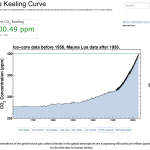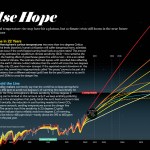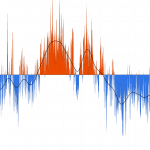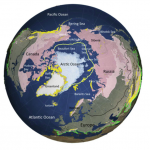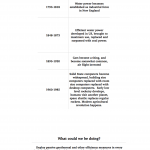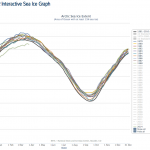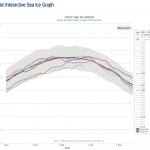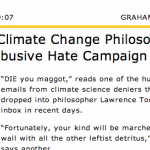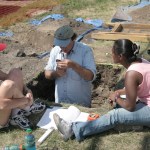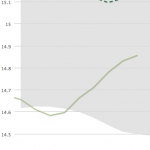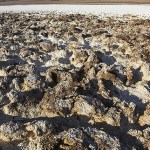Global Warming
This Scripps Institution of Oceanography, UC San Diego website provides daily updates, analysis, and information on the state of climate. Follow @Keeling_curve to get daily updates of the CO2 value. Through this site, the public can also help support the continuation of the iconic Keeling Curve and of complementary measurements of atmospheric oxygen made at Scripps. These measurements enable society to witness climate change and inform strategies to address it.
CLICK THROUGH READ MORE GIVE MONEY
I needed a copy of the "False Hope Graph" that Michael Mann painstakingly created for his Scientific American piece "Earth Will Cross the Climate Danger Threshold by 2036" for a presentation I'm doing, but it had to be simpler, leave some stuff off, and be readable across the room on a screen. The original graphic looks like this:
It is a major contribution showing the relationship between climate sensitivity and climate change in the future depending on various important factors. The graphic I made from it is here (click on it to get the big giant version):
You'll notice I left only one…
It is said that global warming has taken a break over the last decade or so. This is not true. Surface temperatures (air, sea surface, and ice) have increased over this period of time, though less so than previous years. Also, there are various indicators that the coming year or so may be extra warm, depending on what happens in the Pacific Ocean. Perhaps more importantly, deep sea temperatures seem to have gone up, and since most of the effects of anthropogenic global warming are seen in the ocean (over 90% of the extra heat goes there), changes in the rate of global warming at the surface…
Earth’s northern ice cap is heating up and melting down at an alarming, not previously predicted, rate. A paper just out in Wiley Interndisciplary Reviews: Climate Change, by Josefino Comiso and Dorothy Hall looks at recent historic transformations in the Arctic using satellite imagery, mainly from 1979 to the present. The decline of Arctic ice is so extreme that ice thought to have existed for over 1450 years is melting now. (None of the sea ice is really ancient, even the “old” ice recycles over geologically short time periods. But in the near future there will be virtually no “old” ice…
I made this huge giant meme for you. Click on it to see it in your browser all by itself, might be easier to read:
An Open Letter on the Keystone XL Tar Sands Pipeline from Scientists and Economists
April 7 , 2014
President Barack Obama
The White House 1600
Pennsylvania Avenue NW
Washington, DC 20500
Secretary John Kerry
U. S . Department of State
2201 C Street NW
Washington, DC 20520
Dear President Obama and Secretary Kerry,
As scientists and economists, we are concerned about climate change and its impacts. We urge you to reject the Keystone XL tar sands oil pipeline as a project that will contribute to climate change at a time when we should be doing all we can to put clean energy alternatives in…
This is an amazing series of nine episodes looking at climate change. Here's an FAQ on the series by Joe Romm.
It’s the biggest story of our time. Hollywood’s brightest stars and today’s most respected journalists explore the issues of climate change and bring you intimate accounts of triumph and tragedy. YEARS OF LIVING DANGEROUSLY takes you directly to the heart of the matter in this awe-inspiring and cinematic documentary series event from Executive Producers James Cameron, Jerry Weintraub and Arnold Schwarzenegger. YEARS OF LIVING DANGEROUSLY premieres Sunday, April 13 at 10PM ET/PT –…
April 27th, I'll be giving a talk hosted by Minnesota Atheists at the Maplewood Library, 3025 Southlawn Dr, Maplewood, Minnesota. Details are here.
Details:
You may attend any part of the meeting you wish, here's the schedule:
1:00-1:15 p.m. – Social Time
1:15-1:45 p.m. – Business Meeting
1:45-2:00 p.m. – Break
2:00-3:30 p.m. – Talk by Greg Laden
4:00-whenever – Dinner at Pizza Ranch (1845 County Road D East, Maplewood MN)
This will be a talk about climate change focusing on current and challenging research questions that everyone needs to know about, as well as the relationship between…
STFU.
Seriously. For your own good.
Every time you make a move you seem to create your own pile of dog do and step in it. The latest own-goal for those who deny climate science was scored after an unreasonable and obnoxious attack on Professor Lawrence Torcello, of RIT. Details here and here.
Those mentioned above, and others such as the Drudge and Infowars, lied. They lied knowingly, blatantly, obnoxiously. They willfully misconstrued Lawrence Torcello's word and his research in order to make climate scientists look like Hitler. This is not a new tactic and it didn't work before.
And…
I'm going to update this graph every now and then.
There are 12 lines on this graph.
The colorful squiggles up along the top are the first ten years of Arctic Sea ice extent for the period for which we have really good data. So this is 1979 - 1988. There is reason to believe that this is the "normal" sea ice extent track over the year from which we have seen significant deviation over recent decades.
The dark thick line is the average of all of the years from 1979 to 2010. Notice that the first ten years are all above the average except for a few little bits.
The partial line below all…
Michael Mann, Byron Steinman, and Sonya Miller have just put out a new paper on climate change which addresses a number of key concerns. The paper is called “On Forced Temperature Changes, Internal Variability and the AMO.” Here’s the abstract:
We estimate the low-frequency internal variability of Northern Hemisphere (NH) mean temperature using observed temperature variations, which include both forced and internal variability components, and several alternative model simulations of the (natural + anthropogenic) forced component alone. We then generate an ensemble of alternative historical…
Above is the nifty interactive graphic from the National Snow and Ice Data Center showing sea ice extent in the Arctic for the current year (the lower squiggle). This year's squiggle looks like a peak, and it is possible that Arctic Sea ice extent is now on the decline. Minimum extent is typically reached in September.
The other squiggles are all the years since 1979 that seem to have had peaks later in the year than this year's apparent peak of a couple of days ago. Those years are 1992, 1997, 1999, and 2010. In other words, for the available data set, four out of 34 years, or just over…
This is a followup on Are the climate science deniers criminals?, which explored recent work by Lawrence Torcello, a philosopher at Rochester Institute of Technology. (See: Is Organised Climate Science Denial Criminally Negligent?)
Professor Torcello's point was made in part by reference to the tragic events at L'Aquila, Italy, where a screw up mainly by non-scientist government official seems to have resulted in unnecessary deaths due to an earthquake. Torcello notes:
If those with a financial or political interest in inaction had funded an organised campaign to discredit the consensus…
After 16 minutes, Michael Mann on climate change, climate sensitivity, etc.
Why does Joan of Arc Being look so worried? The fire hasn't even touched her!
Mann uses the analogy of a person jumping (or being thrown?) off a tall building, and as he passes the third floor notes that everything is fine. Another analogy that might be helpful is being burned at the stake. After they tie you to the stake and pile up the wood, you're fine. Then they light the wood on fire and you're still fine. For a while.
The climate sensitivity graph above is from here.
It is very hard for me to view the world without my Anthropological glasses, since I’ve been one kind of Anthropologist or another since I was 13 years old. Thinking about climate science deniers, I realized what makes them annoying to me. Let me tell you what I mean.
The ongoing conversation at an archaeological site.
When Archaeologists (a kind of Anthropologist, in the tradition I was trained in) dig a site, they are constantly learning about what is under ground at that location, and throughout the process develop a model of what it all means. As an aside I should mention that…
WTF Frontiers in Psychology Journal? Scientists publish a peer reviewed paper in your journal, a bunch of cranks complain about it, and successfully bully you into taking the paper off your web site? Do you seriously want the rest of the scientific world to take you seriously, ever, from now on? I'm thinking that's not going to happen. We await a full and unmitigated apology to Stephan Lewandowsky, JohnCook, Klaus Oberauer and Michael Marriott, the authors of Recursive fury: conspiracist ideation in the blogosphere in response to research on conspiracist ideation
In the mean time, since you…
Well before mid century we will probably pass a threshold beyond which we'll really regret having not curtailed the release of fossil Carbon into the atmosphere in the form of Carbon Dioxide. The best case scenario for "business as usual" release of the greenhouse gas is that some of the carbon, or some of the heat (from sunlight) gets taken out of the main arena (the atmosphere and sea surface) and buried or reflected somewhere for a while, and this all happens on a slightly delayed time scale.
The reason we know this is a little thing called science. And, more exactly, physics. And…
A few days ago I made a prediction for this year's minimum Arctic Sea Ice extent. That's still valid. Or not. Either way, it's still my prediction.
But looking at the ice over the last few days, we see that for the first time in a while the extent of ice estimated by the NSICD has stopped hugging the -2SD line and is rising upwards like a chilly Phoenix rising out of slush ashes. In fact, one could even say that Arctic Sea Ice has recovered! Just look at the last eight days of data!
Think I'm cherry picking? It's possible, let's look at the larger picture, over a whole year's cycle:…
Our future is at risk. The science is settled, in the main, though there are many details to continue to work out and there are unknowns. But no one doubts that business as usual release of fossil carbon into the atmosphere mainly as the greenhouse gas Carbon Dioxide spells big trouble for humanity and the planet Earth, including eventual massive sea level rise and highly disruptive changes in the Earth’s climatology that will make a mess of many things including our food supply. Think failed state. Think Syria. Now, think failed planet, Syria over half the globe, the other half merely a mess…
Peter Sinclair has tackled this difficult topic with an excellent video and informative blog post. The blog post is here, and I've pasted the video below.
This is a complicated issue. The water problem in California is obviously made worse by increased demands from population growth and expansion of agriculture. Under "normal" (natural) conditions, California and the American Southwest is fairly dry and can undergo extra dry periods. But climate change seems to be playing a role here as well. It appears that recent lack of rain in the region is the result of changes in atmospheric…
